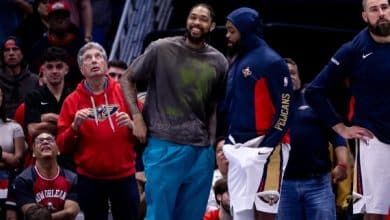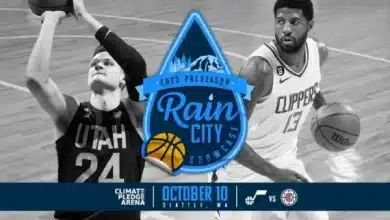
Nate Archibaldthe one nicknamed “Tiny” (tiny in French) because he was 1m83 tall, is the only one to date to have won the titles of best scorer and best passer in the same year! James Harden and Russell Westbrook have almost imitated him in recent years, but they have not succeeded… Maybe Luka Doncic will succeed soon.
Originally from the Bronx, where his parents raise seven children in a two-room apartment, he rubs shoulders with the worst on a daily basis, and at 14, he becomes the head of the family! His father, nicknamed Big Tiny, abandoned his wife and children, and Nate focuses 200% on basketball. Shy and frail, he is gifted at this sport, and even if his physique is a handicap, and his friends try to drag him into drugs, he manages to get a place in a university and his career can finally take off.
Mistaken for a bellhop in a hotel!
“It's interesting to see how guys who do drugs always try to involve other guys, as if they want company when they're down. Me? I've always liked basketball.” he confided in 1980.
Drafted in 1970 by the Cincinnati Royals in the second round, he played under the orders of Bob Cousy, the Celtics legend, who became a coach. But his physique continued to surprise, even shock, to the point that when the Royals' leaders met him in a hotel, they took him for a bellhop! But Tiny Archibald quickly reassured them of his potential, and he achieved a unique feat in his third season. The franchise moved to Kansas City-Omaha, and the Royals became the Kings, and he achieved a performance never equaled in the history of the NBA since he finished as the league's top scorer (34 points per game) and passer (11.4 assists per game). That season, in 1973, he became an All-Star for the first time, and he was named to the All-NBA First Team.
Tiny Archibald takes care of his brothers who are falling into delinquency.
The rest is more complicated… The Kings (36v-46d) fall back in the standings. But more importantly, the Bronx catches up with him, or rather his family. One of his younger brothers is arrested for theft, another for drug trafficking. One evening, returning to his neighborhood, Archibald discovers one of his brothers in the middle of a delirium crisis, after an overdose. Finally, Archibald brings two of his brothers back to Kansas City, while the 3rd is interned in a detoxification center at the player's request.
Added to these family problems was a serious Achilles tendon injury that forced him to play only 35 games. But the best was yet to come. Fully recovered for the following season, Tiny Archibald played all 82 games and for the first time in nine years, the franchise finished with a positive record: (44v-38d). In the wake of his 26.5 points and 6.8 assists, the Kings returned to the playoffs, and Archibald regained a place in the All-NBA First Team.
Even though Archibald kept the same level of play, the Kings did not follow, and in 1976, he was transferred to the New York Nets. This was the beginning of a new period of hardship with serious repeated injuries. Again, he only played about thirty games, and the Nets sent him to the Buffalo Braves (the ancestors of the Clippers). There, it happened again: a ruptured Achilles tendon before even setting foot on the field! He spent a season in the infirmary, and the Braves sent him to the in 1978. In two years, he would meet his 4th team.
“What is sad” laments a GM. “C“I'm not sure anyone would have taken Tiny back then: he was 30, had a bad reputation and a huge contract. He seemed to have lost his game.”
Champion with Boston, MVP of the All-Star Game
We thought he was finished then, but it was there, between 1978 and 1984, that Tiny Archibald would win the title, in 1981. Alongside Larry Bird, Dave Cowens and Cedric Maxwell, he became the perfect leader for this constellation of stars. And it was in the Bronx that he found confidence again. “I was there, coming off the most frustrating year of my career, and it was the kids who gave me advice. They kept telling me, ‘Don’t worry, Tiny. Don’t get discouraged. You can do it. The Celtics need you.’ I’ll never forget them for that.”
With Boston, Archibald once again became one of the best passers in the NBA, and he made history once again, notably with an All-Star Game MVP trophy in 1981, when he was a substitute (like Glen Rice in 1997). Also to his credit, new selections to the All-Star Game and a place in the second All-NBA Team. After the end of his career, on the Bucks side, he returned to his native Bronx to take care of troubled kids. A role that earned him an honor for his work with youth by the Mayor of New York in 1993, but also to pass on his knowledge on passes.
“I tell young people: 'When you go to math class, you know how to add, subtract, multiply', he tells. “I say to them, ‘What does geometry mean to you?’ The kids say, ‘Shapes and angles.’ I say, ‘If you cut the field in half, you have 90-degree angles and 45-degree angles, and those are the attack zones.’
Inducted into the Hall Of Fame in 1991, he is one of the 75 greatest players in NBA history and history will remember that he had under his orders, as an assistant, a certain Tim Hardaway on the Texas-El Paso side. A way of passing the torch to another legend among the “little ones”.
Article originally published on September 2, 2019
| Tiny Archibald | Percentage | Rebounds | |||||||||||||
|---|---|---|---|---|---|---|---|---|---|---|---|---|---|---|---|
| Season | Team | MJ | Min | Shots | 3pts | LF | Off | Def | Early | Pd | Party | Int | Bp | Ct | Pts |
| 1970-71 | CIN | 82 | 35 | 44.4 | 75.7 | 0.0 | 0.0 | 3.0 | 5.0 | 2.0 | 0.0 | 0.0 | 0.0 | 16.0 | |
| 1971-72 | CIN | 76 | 43 | 48.6 | 82.2 | 0.0 | 0.0 | 2.9 | 9.0 | 2.0 | 0.0 | 0.0 | 0.0 | 28.2 | |
| 1972-73 | KCK | 80 | 46 | 48.8 | 84.7 | 0.0 | 0.0 | 2.8 | 11.0 | 2.0 | 0.0 | 0.0 | 0.0 | 34.0 | |
| 1973-74 | KCK | 35 | 36 | 45.1 | 82.0 | 0.0 | 1.0 | 2.4 | 7.0 | 2.0 | 1.0 | 0.0 | 0.0 | 17.6 | |
| 1974-75 | KCK | 82 | 40 | 45.6 | 87.2 | 0.0 | 2.0 | 2.7 | 6.0 | 2.0 | 1.0 | 0.0 | 0.0 | 26.5 | |
| 1975-76 | KCK | 78 | 41 | 45.3 | 80.2 | 0.0 | 1.0 | 2.7 | 7.0 | 2.0 | 1.0 | 0.0 | 0.0 | 24.8 | |
| 1976-77 | NYN | 34 | 38 | 44.6 | 78.5 | 0.0 | 1.0 | 2.4 | 7.0 | 2.0 | 1.0 | 0.0 | 0.0 | 20.5 | |
| 1978-79 | BOS | 69 | 24 | 45.2 | 78.8 | 0.0 | 1.0 | 1.5 | 4.0 | 1.0 | 0.0 | 2.0 | 0.0 | 11.0 | |
| 1979-80 | BOS | 80 | 36 | 48.2 | 22.2 | 83.0 | 0.0 | 1.0 | 2.5 | 8.0 | 2.0 | 1.0 | 3.0 | 0.0 | 14.1 |
| 1980-81 | BOS | 80 | 35 | 49.9 | 0.0 | 81.6 | 0.0 | 1.0 | 2.2 | 7.0 | 2.0 | 0.0 | 3.0 | 0.0 | 13.8 |
| 1981-82 | BOS | 68 | 32 | 47.2 | 37.5 | 74.7 | 0.0 | 1.0 | 1.7 | 7.0 | 1.0 | 0.0 | 2.0 | 0.0 | 12.6 |
| 1982-83 | BOS | 66 | 27 | 42.5 | 20.8 | 74.3 | 0.0 | 1.0 | 1.4 | 6.0 | 1.0 | 0.0 | 2.0 | 0.0 | 10.5 |
| 1983-84 | MIL | 46 | 23 | 48.7 | 22.2 | 63.4 | 0.0 | 1.0 | 1.7 | 3.0 | 1.0 | 0.0 | 1.0 | 0.0 | 7.4 |
| Total | 876 | 36 | 46.7 | 22.4 | 81.0 | 0.0 | 1.0 | 2.3 | 7.0 | 2.0 | 1.0 | 2.0 | 0.0 | 18.8 | |
How to read the stats? GM = Games Played; Min = Minutes; Shots = Shots Made / Shots Attempted; 3pts = 3-pointers / 3-pointers Attempted; LF = Free Throws Made / Free Throws Attempted; Off = Offensive Rebound; Def = Defensive Rebound; Tot = Total Rebounds; Pd = Assists; Fte: Personal Fouls; Int = Steals; Bp = Loose Balls; Ct: Blocks; Pts = Points.












